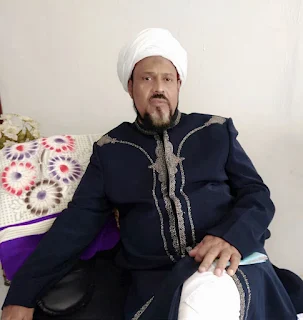Hajj is more than a get-together of Muslims from all over the world; it is akin to a training camp to prepare the Muslims for the afterlife. Pilgrims leave behind their busy world, dress in simple white sheets of cloth not unlike the ones they (all of us Muslims) will later be buried in, and concentrate on the concept of sacrifice - recalling Ibrahim’s willingness to sacrifice his only son Hazrat Ismail (as) for Allah.
Hajj ![]() is the fifth pillar of Islam and is
accomplished every year in the last month of the Islamic Calendar, Dhul-Hijjah
(or The Month of Hajj). All Muslims from around the world now converge to the
Sacred Spot [called Al-Masjid Al-Haram] found in Mecca [Makkah],
in Arabia [Saudi Arabia] to accomplish their pilgrimage. There, a number of
ritual are carried out which reflect the efforts of Hazrat Ibrahim (as), who
had left his second wife Hazrat Hajra (ra) and their young son Hazrat Isma’il
(as) in its vicinity in the arid desert, and Allah rewarded Hajra’s struggle to
find water with the well of Zamzam, a spring which made the region
prosperous and a religious focal point after Hazrat Ibrahim (as) and
Hazrat Isma’il (as) built, or rather rebuilt, the Ka’aba (which existed since
the time of Hazrat Adam (as) but which with time was neglected and forgotten by
the people when they forgot Allah - the worship of one God). Among the rites
and gatherings during the Hajj, there is also the gathering at the plain of
Arafat, which reminiscences of the even larger gathering to come of the Day of
Judgement.
is the fifth pillar of Islam and is
accomplished every year in the last month of the Islamic Calendar, Dhul-Hijjah
(or The Month of Hajj). All Muslims from around the world now converge to the
Sacred Spot [called Al-Masjid Al-Haram] found in Mecca [Makkah],
in Arabia [Saudi Arabia] to accomplish their pilgrimage. There, a number of
ritual are carried out which reflect the efforts of Hazrat Ibrahim (as), who
had left his second wife Hazrat Hajra (ra) and their young son Hazrat Isma’il
(as) in its vicinity in the arid desert, and Allah rewarded Hajra’s struggle to
find water with the well of Zamzam, a spring which made the region
prosperous and a religious focal point after Hazrat Ibrahim (as) and
Hazrat Isma’il (as) built, or rather rebuilt, the Ka’aba (which existed since
the time of Hazrat Adam (as) but which with time was neglected and forgotten by
the people when they forgot Allah - the worship of one God). Among the rites
and gatherings during the Hajj, there is also the gathering at the plain of
Arafat, which reminiscences of the even larger gathering to come of the Day of
Judgement.



.jpg)



